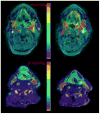Early prediction of outcome in advanced head-and-neck cancer based on tumor blood volume alterations during therapy: a prospective study
- PMID: 19028268
- PMCID: PMC3638953
- DOI: 10.1016/j.ijrobp.2008.08.024
Early prediction of outcome in advanced head-and-neck cancer based on tumor blood volume alterations during therapy: a prospective study
Abstract
Purpose: To assess whether alterations in tumor blood volume (BV) and blood flow (BF) during the early course of chemo-radiotherapy (chemo-RT) for head-and-neck cancer (HNC) predict treatment outcome.
Methods and materials: Fourteen patients receiving concomitant chemo-RT for nonresectable, locally advanced HNC underwent dynamic contrast-enhanced (DCE) MRI scans before therapy and 2 weeks after initiation of chemo-RT. The BV and BF were quantified from DCE MRI. Preradiotherapy BV and BF, as well as their changes during RT, were evaluated separately in the primary gross tumor volume (GTV) and nodal GTV for association with outcomes.
Results: At a median follow-up of 10 months (range, 5-27 months), 9 patients had local-regional controlled disease. One patient had regional failure, 3 had local failures, and 1 had local-regional failure. Reduction in tumor volume after 2 weeks of chemo-RT did not predict for local control. In contrast, the BV in the primary GTV after 2 weeks of chemo-RT was increased significantly in the local control patients compared with the local failure patients (p < 0.03).
Conclusions: Our data suggest that an increase in available primary tumor blood for oxygen extraction during the early course of RT is associated with local control, thus yielding a predictor with potential to modify treatment. These findings require validation in larger studies.
Figures

References
-
- Stadler P, Becker A, Feldmann HJ, et al. Influence of the hypoxic subvolume on the survival of patients with head and neck cancer. Int J Radiat Oncol Biol Phys. 1999;44:749–754. - PubMed
-
- Brizel DM, Dodge RK, Clough RW, Dewhirst MW. Oxygenation of head and neck cancer: changes during radiotherapy and impact on treatment outcome. Radiother Oncol. 1999;53:113–117. - PubMed
-
- Nordsmark M, Overgaard J. A confirmatory prognostic study on oxygenation status and loco-regional control in advanced head and neck squamous cell carcinoma treated by radiation therapy. Radiother Oncol. 2000;57:39–43. - PubMed
-
- Hermans R, Meijerink M, Van den Bogaert W, Rijnders A, Weltens C, Lambin P. Tumor perfusion rate determined noninvasively by dynamic computed tomography predicts outcome in head-and-neck cancer after radiotherapy. Int J Radiat Oncol Biol Phys. 2003;57:1351–1356. - PubMed
Publication types
MeSH terms
Substances
Grants and funding
LinkOut - more resources
Full Text Sources
Medical
Miscellaneous

